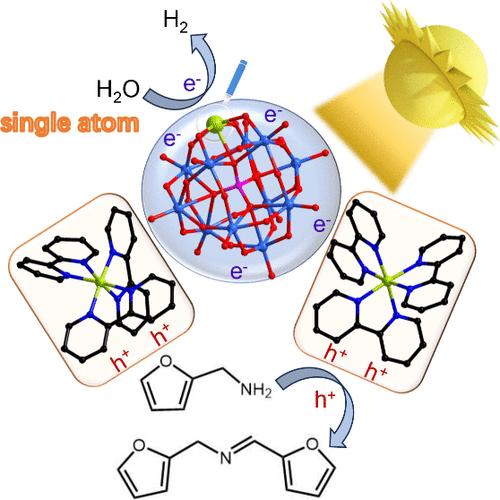基于多金属氧酸盐的单原子光催化剂与糠醛胺选择性氧化耦联制氢
IF 7.3
1区 化学
Q1 CHEMISTRY, MULTIDISCIPLINARY
引用次数: 0
摘要
通过水裂解光催化制氢面临着固有的挑战,包括气体产物分离的必要性和析氧反应的热力学限制。在此,我们提出了一种新的策略,通过在统一的光催化系统中整合析氢半反应和增值糠胺氧化转化来绕过这些障碍。多金属氧酸盐负载的单原子光催化剂在光激发下同步驱动两个氧化还原过程表现出优异的性能。系统研究表明,光电子能有效地还原质子生成H2(演化速率为494 umol·g-1·h-1),而相应的空穴则能以99%的选择性催化糠醛胺氧化生成n -糠醛基呋喃胺。通过先进的结构表征(x射线单晶衍射仪)和密度泛函理论,我们建立了原子分散的金属中心与空隙多金属氧酸盐框架协同产生开放的活性位点,显著提高了界面电荷转移动力学(与纳米颗粒相比提高了3.7倍)。这种协同结构不仅抑制了电子-空穴复合,而且为有机基质提供了最佳的吸附结构。据我们所知,这项工作首次展示了使用多金属氧酸盐锚定的单原子光催化剂通过耦合制氢和生物质增值来构建一个封闭的氧化还原循环。本文章由计算机程序翻译,如有差异,请以英文原文为准。

Polyoxometalate-Based Single-Atom Photocatalyst for Hydrogen Production Coupled with Selective Furfurylamine Oxidation
Photocatalytic H2 generation through water splitting faces inherent challenges, including the necessity for gas product separation and thermodynamic limitations of the oxygen evolution reaction. Herein, we propose a novel strategy to circumvent these obstacles by integrating the hydrogen evolution half-reaction with value-added furfurylamine oxidative transformation in a unified photocatalytic system. A polyoxometalate-supported single-atom photocatalyst demonstrates exceptional performance in synchronously driving both redox processes under photoexcitation. Systematic investigations reveal that photogenerated electrons efficiently reduce protons to generate H2 (evolution rate: 494 umol·g–1·h–1), while the corresponding holes mediate selective oxidation of furfurylamine to N-furfurylidenefurfurylamine with 99% selectivity. Through advanced structural characterization (X-ray single crystal diffractometer) and density functional theory, we establish that the atomically dispersed metal centers coordinated with lacunary polyoxometalate frameworks create open active sites that significantly enhance interfacial charge transfer kinetics (improved by 3.7 times compared to nanoparticle counterparts). This synergistic configuration not only suppresses electron–hole recombination but also provides optimal adsorption configurations for organic substrates. To our knowledge, this work represents the first demonstration of constructing a closed redox cycle through coupled hydrogen production and biomass valorization using polyoxometalate-anchored single-atom photocatalysts.
求助全文
通过发布文献求助,成功后即可免费获取论文全文。
去求助
来源期刊

ACS Sustainable Chemistry & Engineering
CHEMISTRY, MULTIDISCIPLINARY-ENGINEERING, CHEMICAL
CiteScore
13.80
自引率
4.80%
发文量
1470
审稿时长
1.7 months
期刊介绍:
ACS Sustainable Chemistry & Engineering is a prestigious weekly peer-reviewed scientific journal published by the American Chemical Society. Dedicated to advancing the principles of green chemistry and green engineering, it covers a wide array of research topics including green chemistry, green engineering, biomass, alternative energy, and life cycle assessment.
The journal welcomes submissions in various formats, including Letters, Articles, Features, and Perspectives (Reviews), that address the challenges of sustainability in the chemical enterprise and contribute to the advancement of sustainable practices. Join us in shaping the future of sustainable chemistry and engineering.
 求助内容:
求助内容: 应助结果提醒方式:
应助结果提醒方式:


